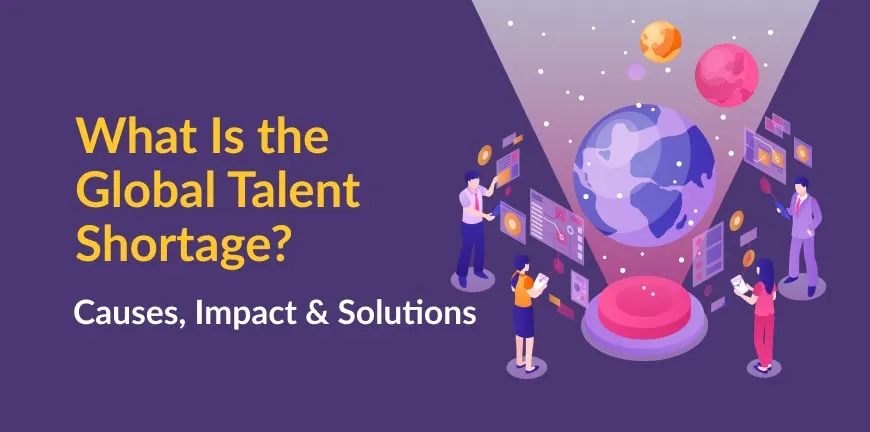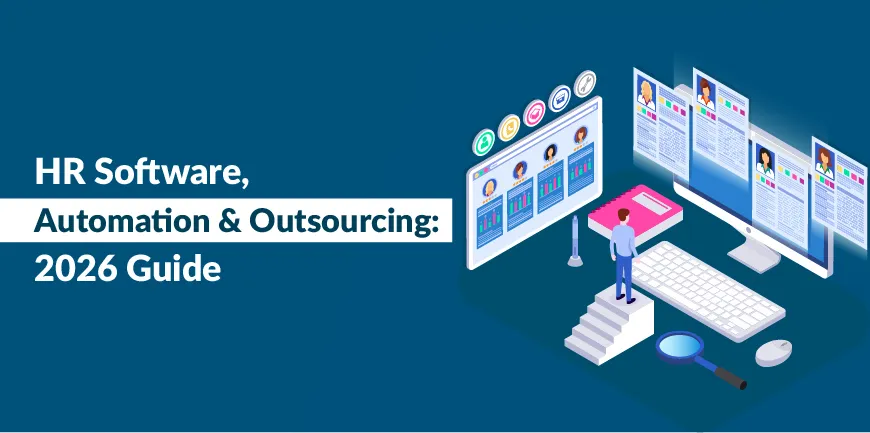
What is Talent Management? Guide for HR Leaders in 2025
25/08/2025
What Is the Difference Between Hiring and Recruiting?
25/08/2025- What Does Global Talent Shortage Mean?
- What Are the Main Causes of the Global Talent Shortage?
- What Are the Global Talent Shortage Statistics in 2025?
- What Are the Consequences of the Global Talent Shortage for Employers?
- Which Industries Are Most Affected by the Global Talent Shortage?
- How Can Businesses Overcome the Global Talent Shortage?
- What Is the Future of the Global Talent Shortage?
- Key Takeaways
- Frequently Asked Questions (FAQ’s)
Across the world, organizations have been searching for the right kind of talent to fill roles. You also must have experienced it sometime or the other. The fact is, the world is not exhausting all jobs, but it is losing out on or not connecting with people who have the right skills to perform the jobs.
The global talent shortage or talent crunch is a phenomenon that is affecting domains across industries. The pattern is dangerous and is altering the future of work. According to experts, by 2030, millions of roles could remain vacant, costing trillions in lost economic opportunity.
The challenge must be collectively combated by organizations, stakeholders, and recruiters. If you are an organization, it is like an alarm bell for you to wake up and compete for talent like you once competed for clients.
You will emerge as a winner if you reimagine your strategies to find, draw, build, and retain individuals. It is a new dawn where skills, innovative technology, and adaptability are what matter.
As per Mark Hedley, VP of Recruitment at Globalization Partners, “There is no shortage if companies take a global approach…There is talent everywhere.”
What Does Global Talent Shortage Mean?
Global talent scarcity, in simple terms, means the dearth of skilled individuals to fill niche and high-demand roles.
Organizations today are grappling with finding qualified professionals, as there is not a shortage of people, but the problem lies in matching skilled people to suitable job openings.
According to a survey by Gartner, 78% of CEOs identify that talent scarcity is reaching crisis levels, and 57% of HR leaders believe skills shortages obstruct their organization’s sustained corporate performance.
What Are the Main Causes of the Global Talent Shortage?
Comprehending the intricacies of today’s transforming workforce is quite a feat. So is solving the complicated puzzle of talent shortage. We must first understand and dive into the sea of factors causing the drought. Let us look at some of the factors:
1. Population Dynamics
There is the problem of the senior population in many countries, which has resulted in a diminishing workforce. The shift is a disadvantage for talent pools as they are reduced, and there is a scarcity in sectors that require niche talent.
2. Talent Misalignment
Today, the industry demands are fast evolving, and institutions and training modules often fail to cater to these needs. Furthermore, certain qualifications are not relevant today, and old degrees do not always help graduates, as they lack the latest skills that are in demand.
3. Technological Revolution
The advent of advanced technology like AI has changed the face of the job market by opening new job segments rapidly, before the workforce is trained. Then there is niche expertise required for jobs in emerging sectors like renewable energy, climate tech, cybersecurity, etc.
4. Geoeconomic Factors
The geographical locations and restrictions on crossing borders can restrict talent flow from various regions. There is a disparity in economic development in regions where some places might have a surplus of labour who are low-skilled, while some will have a scarcity of high-skilled individuals. There is also an issue of urban and rural discrimination.
5. Post Covid Aftermaths
The pandemic caused quite a stir in the labour market with older professionals retiring early. Workers who had to exit did not transition easily into new industries. There was a massive crisis in the healthcare sector, where a bulk of healthcare professionals had to leave their workplaces.
6. Organizational Restraints
Some employers are still very reliant on the credentials, past experiences of candidates, rather than considering their skills. There is a lack of active training programs that enable reskilling faster. Organizations also face difficulties in retaining skilled talent due to a dearth of career scope and engagement.
7. Globalization
The talent market is cutthroat, with globalization leading the change. Companies now must attract top-notch professionals from both local and global markets, making it a challenging scenario for them to compete and fill gaps in roles.
What Are the Global Talent Shortage Statistics in 2025?
To give you an idea of what the global talent scarcity looks like in 2025, here are some of the global talent shortage statistics:
| Area | 2025 Estimate / Insight |
| Global employer difficulty | 75% can’t find skilled talent
|
| Top-affected industries | IT (76%), Healthcare (77%), Energy (76%) |
| Economic impact forecast | Up to $3.8T loss in 2025; $8.5T annually by 2030 |
| Project management needs | +30M professionals by 2035 |
| Cybersecurity shortfall | 4.8M globally; 450K in the US |
| Healthcare worker deficit | 10M globally by 2030 |
| Green energy professionals | +14M needed by 2025
|
What It Means?
- There is a problem with workforce preparedness, and neither the existing employees nor the new graduates can keep up with changing demands.
- The shortage does not affect every region or sector equally and is impacted by factors like innovation pace, structural changes, population alterations, etc.
- There is an emerging trend of developing talent internally and upgrading skills, proving to be critical to bridge the gap.
- The addressing of this shortage must be a top priority for leaders, organizations, and visionaries, as it might lead to a massive loss of capital and productivity.
What Are the Consequences of the Global Talent Shortage for Employers?
Employers will have to bear the brunt of the rising talent crunch. Let us make you aware of some of the consequences so that you, as an employer, can fight the challenges strategically:
1. Surging Costs and More Hiring Time
Companies will have to face the problem of rising costs as they need to attract limited talent by offering them high salaries, perks, bonuses, etc. They will have to spend extra on head-hunters, hiring agencies to draw the best talent. Then there is the issue of unfilled vacancies that can take months to fill.
2. Diminished Productivity and Innovative Ideas
The productivity of organizations largely depends on their workforce, and if the workers are not skilled enough, then businesses will face inefficiencies in functions, misalignments, missed deadlines, and the flow of work will be adversely impacted.
With skilled talent missing, there will also be zero inflow of new and innovative perspectives and suggestions.
3. Growth and Competitiveness are Hampered.
A company’s ability to put the best foot forward and compete, along with its ability to execute its goals, gets hindered, leading to a downfall in the overall company development.
Additionally, the lack of skilled professionals also drives the company to lose out on agility, making it hard to adapt to new market innovations.
4. Employee Fatigue and Churn Out
Employees in organizations must take on an extra workload due to vacant job positions. This will make them feel the heat and burden, so they tend to suffer from burnout as they feel overworked. The discontent makes employees leave companies at a faster rate.
5. Supply Chain and Operational Disturbances
An organization faces issues related to the quality of production and execution of operations due to a lack of a skilled labour force. This will lead to slowdowns and customer dissatisfaction, as they cannot serve clients efficiently and effectively.
6. Impeded Global Expansion Plans
An enterprise looking forward to growing globally and wanting to expand its operations might face challenges as it will lack niche talent to compete in the global arena. It will lose its opportunity to grow globally and meet far-reaching objectives.
Which Industries Are Most Affected by the Global Talent Shortage?
We will give you an overview of the sectors that are most impacted by the global talent crunch:
- Technology- The global tech talent shortage is one of the top industries being affected. There is a dire need for skilled workers in this sector, especially in domains like data science, software development, cybersecurity, etc.
- Energy Sector- This sector is relatively new, and it demands a slew of niche workers in areas like green energy, sustainability, power generation, etc.
- Healthcare- Healthcare is an industry that will always demand professionals in various areas, and the demand keeps growing. The requirement of professionals like nurses and individuals in primary care is always present.
- Manufacturing- Areas in manufacturing like machining, welding, etc, require skilled manpower.
- Education- Education is another industry that has its problem of talent shortage, with areas like STEM development, science, engineering, and technology facing the challenge.
- Sectors like agriculture and logistics are also facing problems with talent shortage in various areas, like in the agriculture sector, farming and animal science are areas facing issues, while in logistics and transportation domains, like logistics management, warehousing, etc, are challenged.
How Can Businesses Overcome the Global Talent Shortage?
The success of your business will be significantly impacted if you do not get the talent drought under control. To win the business race, you need a steady strategy to overcome the challenge. Let us take you through some of the solutions:
1. Expanding the Periphery
You can focus on hiring globally and offer flexible work modules. This will enable you to tap into individuals with specialized skills from various regions. You can also spot regions where the availability of skilled talent is high and use modern analytics methods to comprehend the trends of the region and why the talent is high.
2. Upgrading Existing Employees
Your focus must be on developing individuals who already work in your company by investing in training and mentorship programs to prepare them for new job positions. As industries evolve, the workforce also must evolve, and the development programs uplift the morale of employees, driving them to learn and contribute fully.
3. Strengthening Hiring and Retention
To enhance your recruitment methods, you must focus on creating a robust brand image that highlights your strengths, company values, work scope and environment, and career opportunities you offer.
This way, you will draw potential talent who would love to work and stay long-term in your organization. Additionally, you can capitalize on modern tech to make your recruitment processes smooth.
What Is the Future of the Global Talent Shortage?
The trends that are shaping the future of the global talent crunch can be adopted by companies to battle the situation. Let us explore some of them:
- Improve work design with AI- The productivity of a company can be enhanced by implementing work structures powered by AI, enabling smarter assessment systems.
- Digitally enabled teams- Creating digitally savvy teams can establish a thriving and adaptive work environment.
- Evolving skills requirement- The future job requirements will be different and will require new types of skill sets. The labour force needs to be trained and developed to adopt such skills.
- Eventual economic effects- As businesses will not have adequate talent to deliver services or innovations, the revenue that could be generated now will be stalled. As companies will not grow, the entire global economy will slow down.
- Ripple effects in industries- There will likely be growth and operational delays in several sectors due to the shortage. Lack of suitable talent might hinder digital transformation, hike healthcare costs, and delay attainment of climate goals.
Key Takeaways
- Global talent shortage is intensifying
- Numerous reasons drive the crunch
- Hard-hitting consequences for a few sectors
- Businesses face critical impacts
- The solution lies in revising global hiring plans
Frequently Asked Questions (FAQ’s)
1. What is meant by global talent scarcity?
A global talent scarcity occurs when there is a wide gap when the demand for skilled labour and exceeds supply.
2. What are the latest global talent shortage statistics?
The latest statistics, as per the survey, state that around 74% of employers worldwide are finding it challenging to fill vacancies.
3. Why is there a global tech talent shortage?
The global tech crunch is driven by factors like rapidly evolving technology, a slow-paced education system, an aging labour force, etc.
4. How does the talent shortage impact companies?
Talent shortages affect organizations by hindering their growth, increasing expenses, and hampering productivity as they find it difficult to fill talent gaps with skilled people.
5. Which industries face the highest global talent shortage?
A few of the sectors facing a high global talent crunch are IT, healthcare and life sciences, the energy sector, and manufacturing etc.
6. What strategies can businesses use to reduce the talent shortage?
To reduce talent shortage, businesses can introduce upskilling and reskilling programs, expand their reach globally in attracting talent, enhance employer branding, etc.
7. Will AI and automation solve the global talent shortage?
AI and automation can, to some extent, address the talent shortage by assisting IT professionals, providing training services, etc.
Contact Us For Business Enquiry

Rajkumar Shanmugam
Rajkumar Shanmugam is the Head of HR at ALP Consulting, bringing over 19 years of comprehensive HR leadership experience across India and international markets. His expertise spans talent acquisition, employee relations, performance management, compliance, and HR transformation. Rajkumar has a proven track record of driving people-centric initiatives, enhancing workplace culture, and aligning HR strategy with business goals. With extensive experience in US staffing operations and global mobility, he continues to lead organizational excellence through innovation and employee engagement.




